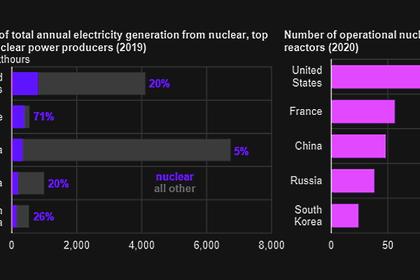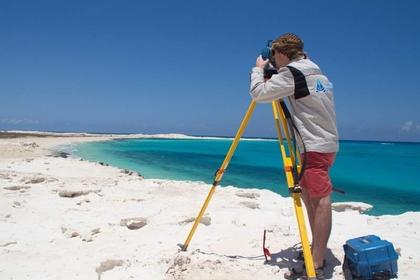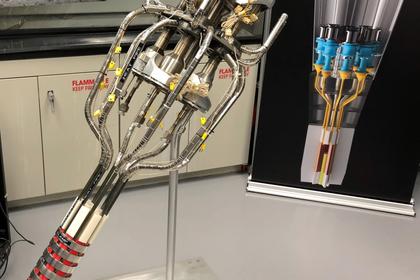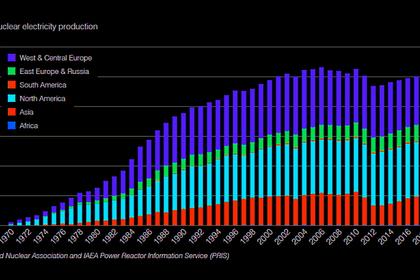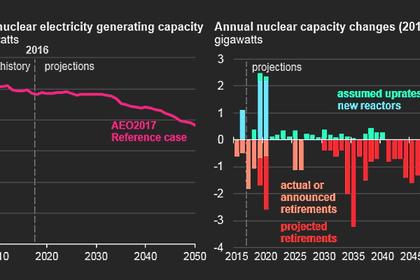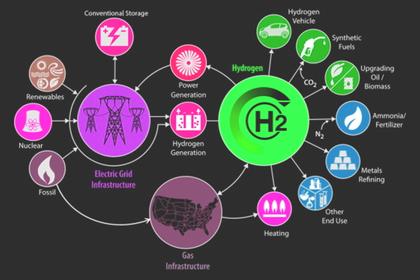
NUCLEAR POWER RACE
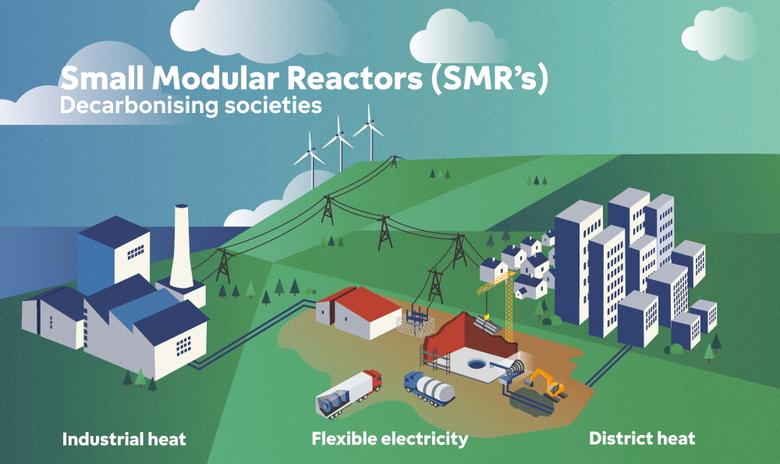
BNN BLOOMBERG - Aug 31, 2020 - The nuclear industry has been stalled for years now, struggling to compete with cheaper forms of power and viewed as suspect ever since the accidents at Fukushima, Chernobyl and Three Mile Island. Only two reactors are being built in the U.S., in Georgia, and they are years behind schedule and weighed down by cost overruns and political opposition.
But now there’s a race to take nuclear power in a radically different direction in a bid to revive the industry. Companies around the world, including NuScale Power LLC in the U.S., China National Nuclear Corp. and Russia’s Rosatom, are developing a new generation of reactors, with some designs that will be more than 90% smaller than the hulking facilities that have dominated the industry for decades. One model can even fit into a single-family house.
These power plants are designed to be faster and easier to build, and may make nuclear energy an affordable—and cleaner—option in developing nations that don’t need huge reactors. Some climate activists, while welcoming the potential of carbon-free electricity, aren’t entirely sold on the argument. They still worry about their safety. And, with the cost of solar and wind plunging, some wonder if small reactors make economic sense even with their lower price tags.
But as governments around the world set ambitious plans to wean themselves off fossil fuels, there’s a growing awareness that closing coal or natural gas plants could lead to electricity shortfalls, as seen in California’s rolling blackouts earlier this month. Nuclear power accounts for 20% of U.S. power, a number that could grow if small nuclear sites are put in place to ease that transition. Supporters anticipate a renaissance in fission that could draw $5.9 trillion in global investment through 2050.
“At least for now, and for the foreseeable future it’s difficult to see a renewables-only energy system,” said Chris Colbert, chief strategy officer at Portland, Oregon-based NuScale.
Advocates say small modular reactors, or SMRs as they’re generally called, can be built at factories, delivered by truck or train, and then assembled on-site, saving time and money. Utilities can install just one or bundle several together, expanding the potential market by including countries that don’t need a big conventional nuclear plant. Some designs will also provide industrial heat as well as electricity—one potential use is in remote villages in far northern latitudes that need both.
China National Nuclear was the first to pass an International Atomic Energy Agency safety review for an SMR design. It began building a demonstration version of its 125-megawatt Nimble Dragon plant in 2019. And in Russia, Rosatom last year introduced the world’s first operational SMR, on a ship that can be sent all over the world. Companies in South Korea, Canada and the U.K. are also developing similar designs.
In the U.S., NuScale is working on a 60-megawatt reactor design, enough to power 48,000 U.S. homes, and its design just won approval from the Nuclear Regulatory Commission this month. The cylindrical power generator would be about 65 feet tall and 9 feet in diameter. That’s tiny compared to big, conventional reactors that typically have about 1,000 megawatts of capacity. And it’s less expensive. A single power plant with 12 NuScale reactor-modules linked together would cost about $3 billion, compared to some major projects that have exceeded $20 billion for conventional nuclear plants. NuScale’s first commercial plant would go into service in Idaho in 2029 if all goes as planned.
NuScale’s design is based on the the pressurized water reactors that are widely used now in conventional nuclear plants, so the technology is familiar to regulators and developers. Other developers are trying different technologies. Oklo Inc., based in Sunnyvale, California, is working on a so-called fast reactor that could use nuclear waste from existing power plants as fuel, and is cooled with a liquid alkaline metal instead of water. And billionaire Bill Gates is backing TerraPower LLC, which is working on another type of fast reactor that uses liquid sodium as coolant.
“There’s a race, sort of like at the dawn of nuclear energy,” said Ted Jones, senior director for national security and international programs at the Nuclear Energy Institute, the industry’s trade association.
The small plants are also safer, the developers say. The key risk from a nuclear plant is that radiation could leak, but since smaller reactors have less nuclear material at their cores, there’s less potential risk. NuScale says its designs could be installed in below-ground water pools, which would minimize the risk of failure because they wouldn’t need pumps to circulate water for cooling.
But along with a smaller size, these new designs may also have smaller and weaker systems to control a potential radiation leak, said Edwin Lyman, director of nuclear power safety at the Union of Concerned Scientists. That’s worrisome because there’s also been a push to build SMRs closer to population centers, he said.
“You could have a smaller reactor but weaker containment and less distance to population centers,” Lyman said. “Paradoxically, a small reactor could end up releasing more material than a large reactor.”
Small reactors are seen as a key to reviving an industry that’s far from thriving now. Construction of conventional nuclear plants is at a 10-year low. There were 52 under construction globally in the first quarter, the lowest in a decade, according to BloombergNEF. And more than 20% of those projects are facing challenges that could derail them, including financing issues and political opposition.
The only nuclear project in the U.S. are the two reactors at Plant Vogtle in Georgia, an effort that’s now years behind schedule and has doubled in cost to more than $28 billion. The $21 billion V.C. Summer plant in South Carolina was abandoned in 2017 after the lead contractor went bankrupt.
Small reactors could change the equation, and the catalyst will be efforts to rein in climate change, according to Brett Rampal, nuclear team manager for the research group Clean Air Task Force. More than a dozen U.S. states and territories have moved to require carbon-free electricity grids, led by California’s plan to eliminate carbon altogether by 2045.
While solar and wind installations are surging, they can’t supply power around the clock. That was part of the reason California, which retired 9 gigawatts of gas plants in recent years, had power shortages and blackouts earlier this month as a heat wave drove up demand for power. Closing baseload power plants can create a gap, said Rampal. “These advanced reactors are looking to fill that.”
Oklo’s reactor would have 1.5 megawatts of capacity, would be small enough to fit inside a house and will have enough output to run about 1,200 U.S. homes. The NRC accepted the company’s application for a license in March, the first to use a new evaluation process that the agency implemented to accelerate the review process. Jacob DeWitte, Oklo’s chief executive officer and co-founder, said the design could win approval within two years and it may have the system in operation a year after that.
“Nuclear is a really important part of what our climate solutions will be,” DeWitte said. “This is where things are going.”
But there are questions about whether small nuclear plants will be cost-competitive in an age of renewables. NuScale, for instance, is aiming for a power plant that can sell power for $55 a megawatt-hour. TerraPower is developing a 345-megawatt reactor that would have a levelized cost of electricity of $50 a megawatt-hour. It can be linked to a system that stores heat in molten salt to produce additional power at times of high demand. CEO Chris Levesque said that would boost capacity to 500 megawatts and reduce the cost to $40. The TerraPower system is expected to cost $1 billion, and Levesque said a demonstration plant could be in operation by 2028. That type of flexibility would have been very helpful when California ran short of power earlier this month.
“We believe there’s going to be a need for many plants like this,” Levesque said.
Yet wind power in much of the world is now about $44 a megawatt-hour and solar is $50. In some regions, renewable energy will be below $20 a megawatt hour by the end of the decade, according to BloombergNEF.
“The logic behind building small modular reactors doesn’t make sense economically,” said Lyman.
The shift comes as the U.S. badly lags other countries in building big reactors. Most of that market now is dominated by Russia and China, while the U. S. is “entirely absent,” according to a March report from the Energy Department, which flagged the development as a significant blow to U.S. strategic interests.
The U.S. is taking steps to address this, notably by lifting a ban on providing government funding for nuclear projects in other countries, especially emerging markets. Most of any future nuclear exports will be small nuclear designs, according to Chris Gadomski, nuclear analyst for BloombergNEF.
“We’re not going to be exporting large reactors anymore,” he said. “Little countries don’t need big reactors.”
-----
Earlier:

